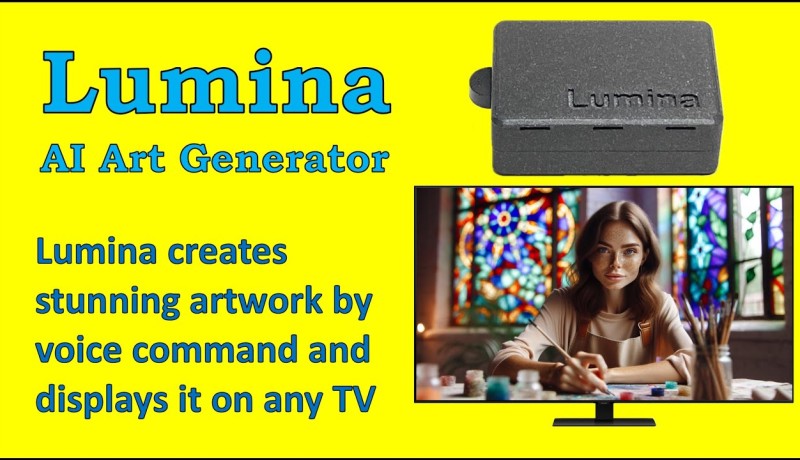Lumina: A Raspberry Pi-Based AI Art Generator
February 08, 2024
on
on

We're constantly scouring the internet for intriguing Raspberry Pi-based projects to highlight, and we've recently discovered one that really stands out: it's named Lumina.
Created by DevMiser, a developer with a keen interest in microcontroller programming, robotics, artificial intelligence, and 3D design, Lumina stands out for its ability to turn voice commands into visual art displayed on your television. This project utilizes a Raspberry Pi 4 running a Python program, harnessing the capabilities of Picovoice's voice recognition technology and OpenAI's DALL-E 3 to translate requests into images.
Simply connect it to an HDMI input on your TV, plug a USB cable into the Raspberry Pi to give it power, and it's all set! Once operational, Lumina listens for a wake word, processes voice commands, and uses DALL-E 3 to create and show the requested artwork on the TV screen.
To see Lumina in action, DevMiser has provided a video demonstration, you can watch it below:
This project aims to make AI art generators like OpenAI's DALL-E 3 even easier to use for everyone. DevMiser's goal was to create a device that not only makes it easy for anyone to voice out their creative ideas but also to display them on a large, conveniently located screen: your television.
Those interested in building their own Lumina will need OpenAI and Picovoice accounts to obtain the necessary API keys for voice command processing and AI art generation. Comprehensive guidance for setting up and running Lumina is available on DevMiser’s GitHub repository
Some readers may recall that Lumina was also the name of a nice Bluetooth Low Energy connected lamp, described in Elektor magazine in March 2016… Elektor hasn't trademarked the name, and it's nice to see that several very cool projects, each in their own genre, can share a cool name!
Created by DevMiser, a developer with a keen interest in microcontroller programming, robotics, artificial intelligence, and 3D design, Lumina stands out for its ability to turn voice commands into visual art displayed on your television. This project utilizes a Raspberry Pi 4 running a Python program, harnessing the capabilities of Picovoice's voice recognition technology and OpenAI's DALL-E 3 to translate requests into images.
Simply connect it to an HDMI input on your TV, plug a USB cable into the Raspberry Pi to give it power, and it's all set! Once operational, Lumina listens for a wake word, processes voice commands, and uses DALL-E 3 to create and show the requested artwork on the TV screen.
To see Lumina in action, DevMiser has provided a video demonstration, you can watch it below:
This project aims to make AI art generators like OpenAI's DALL-E 3 even easier to use for everyone. DevMiser's goal was to create a device that not only makes it easy for anyone to voice out their creative ideas but also to display them on a large, conveniently located screen: your television.
Those interested in building their own Lumina will need OpenAI and Picovoice accounts to obtain the necessary API keys for voice command processing and AI art generation. Comprehensive guidance for setting up and running Lumina is available on DevMiser’s GitHub repository
Some readers may recall that Lumina was also the name of a nice Bluetooth Low Energy connected lamp, described in Elektor magazine in March 2016… Elektor hasn't trademarked the name, and it's nice to see that several very cool projects, each in their own genre, can share a cool name!
Subscribe
Tag alert: Subscribe to the tag Artificial Intelligence and you will receive an e-mail as soon as a new item about it is published on our website! Read full article
Hide full article





Discussion (2 comments)